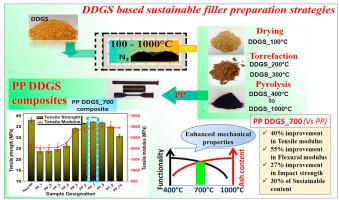Composites Part B: Engineering ( IF 12.7 ) Pub Date : 2021-02-22 , DOI: 10.1016/j.compositesb.2021.108714 Drupitha M. Paleri , Arturo Rodriguez-Uribe , Manjusri Misra , Amar Kumar Mohanty

|
This study targets the value-added engineering applications of Distillers’ dried grains with solubles (DDGS), a co-product from corn ethanol industry in lightweight biocomposites. The DDGS derived carbonaceous materials produced through torrefaction and pyrolysis were used as fillers for the manufacture of polypropylene (PP) based biocomposites. A systematic study was conducted for the first time in scientific literature in which the DDGS was heat treated from 100 to 1000 °C (torrefaction; 200–300 °C and pyrolysis; 400–1000 °C) and used in the biocomposites with a fixed 30 wt % content. With increase in temperature of pyrolysis, the functional groups of the filler were removed, and the ash content was increased. The biocomposites showed their best performance in terms of stiffness-toughness balance with biocarbon pyrolyzed at 700 °C, because of its non-polarity compared to the DDGS_400 °C, and lower ash content and particle size than the DDGS_1000 °C. Comparatively improved compatibility between the DDGS_700 °C and PP resulted in higher complex viscosity and storage modulus than the rest of biocomposites. Overall, this study shows the importance of understanding and optimizing the heat treatment temperature for the production of biocarbon used as a filler in biocomposites based on the specific properties, application, yield, and hence cost effectiveness of the filler.
中文翻译:

玉米乙醇工业副产品及其聚丙烯基复合材料的热解生物质:热处理温度对生物复合材料性能的影响
这项研究的目标是利用玉米酒精工业中的轻质生物复合材料的副产品蒸馏酒干谷可溶物(DDGS)的增值工程应用。通过焙烧和热解产生的DDGS衍生的碳质材料被用作制造聚丙烯(PP)基生物复合材料的填充剂。在科学文献中首次进行了系统的研究,其中将DDGS从100到1000°C进行热处理(折射; 200–300°C和热解; 400–1000°C),并以固定浓度用于生物复合材料中。 30重量%的含量。随着热解温度的升高,填料的官能团被去除,并且灰分含量增加。在700℃下热解的生物碳在刚度-韧性平衡方面,生物复合材料表现出最佳的性能,因为与DDGS_400°C相比,它具有非极性,并且比DDGS_1000°C的灰分和粒径更低。DDGS_700°C和PP之间的相容性相对提高,导致复数粘度和储能模量高于其他生物复合材料。总体而言,这项研究表明,基于填料的特定性能,用途,产量以及因此的成本效益,了解和优化热处理温度对于生产用作生物复合材料填料的生物碳非常重要。











































 京公网安备 11010802027423号
京公网安备 11010802027423号